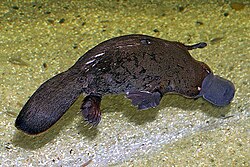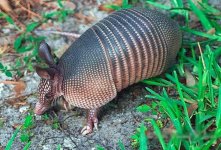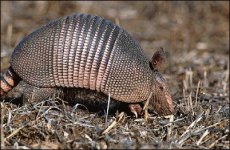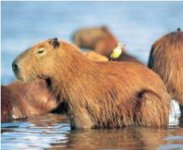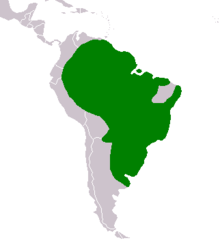The
capybara (
Hydrochoerus hydrochaeris) is the largest
extant rodent in the world. Its closest relatives are
agouti,
chinchillas,
coyphillas, and
guinea pigs. Native to
South America, the capybara inhabits
savannas and dense forests and lives near bodies of water. It is a highly social species and can be found in groups as large as 100 individuals, but usually lives in groups of 10–20 individuals. The capybara is not a threatened species, though it is hunted for its meat and skin.
Etymology
Its
common name is derived from Tupi
ka'apiûara, a complex agglutination of
kaá(leaf) +
píi (slender) +
ú (eat) +
ara (a suffix for agent nouns), meaning "one who eats slender leafs", or "grass-eater".[SUP]
[2][/SUP] The
scientific name, both
hydrochoerus and
hydrochaeris, comes from
Greek ὕδωρ (
hydor = water) +
χοίρος(
choiros = pig, hog).[SUP]
[3][/SUP][SUP]
[4][/SUP]
Classification and phylogeny
The capybara and the
lesser capybara belong to the subfamily
Hydrochoerinae along with the
rock cavies. The living capybaras and their
extinct relatives were previously classified in their own family Hydrochoeridae.[SUP]
[5][/SUP] Since 2002, molecular phylogenetic studies have recognized a close relationship between
Hydrochoerus and
Kerodon[SUP]
[6][/SUP] supporting placement of both genera in a subfamily of
Caviidae.[SUP]
[3][/SUP] Paleontological classifications have yet to incorporate this new taxonomy, and continue to use Hydrochoeridae for all capybaras, while using Hydrochoerinae for the living genus and its closest fossil relatives, such as
Neochoerus.[SUP]
[7][/SUP][SUP]
[8][/SUP] The taxonomy of fossil hydrochoerines is also in a state of flux. In recent years, the diversity of fossil hydrochoerines has been substantially reduced.[SUP]
[7][/SUP][SUP]
[8][/SUP] This is largely due to the recognition that capybara
molar teeth show strong variation in shape over the life of an individual.[SUP]
[7][/SUP] In one instance, material once referred to four genera and seven species on the basis of differences in molar shape is now thought to represent differently aged individuals of a single species,
Cardiatherium paranense.[SUP]
[7][/SUP]
Description


Skull
The capybara has a heavy,
barrel-shaped body and short head, with reddish-brown fur on the upper part of its body that turns yellowish-brown underneath. Its sweat glands can be found in its haired skin surface, an unusual trait among rodents.[SUP]
[5][/SUP] The animal lacks underhair, guard hair differs little from overhair. Adult capybaras grow to 107 to 134 cm (3.51 to 4.40 ft) in length, stand 50 to 64 cm (20 to 25 in) tall at the
withers, and typically weigh 35 to 66 kg (77 to 150 lb), with an average in the
Venezuelan llanos of 48.9 kg (108 lb).[SUP]
[9][/SUP][SUP]
[10][/SUP] The top recorded weight are 91 kg (200 lb) for a wild female from
Brazil and 73.5 kg (162 lb) for a wild male from
Uruguay.[SUP]
[5][/SUP][SUP]
[11][/SUP] The
dental formula is
.[SUP]
[5][/SUP] Capybaras have slightly
webbed feet and
vestigial tails.[SUP]
[5][/SUP] Their back legs are slightly longer than their front legs, and their muzzles are blunt with eyes, nostrils, and ears on top of their heads. Females are slightly heavier than males.
Its
karyotype has
2n = 66 and
FN = 102.[SUP]
[3][/SUP]
Ecology
Capybaras are semiaquatic mammals[SUP]
[10][/SUP]found throughout almost all countries of South America (except
Chile[SUP]
[12][/SUP]) in densely
forestedareas near bodies of water, such as lakes, rivers, swamps, ponds and marshes,[SUP]
[9][/SUP] as well as flooded
savannah and along rivers in
tropical forest. Capybara have flourished in cattle ranches.[SUP]
[5][/SUP] They roam in home
rangesaveraging 10 hectares (25 acres) in high-density populations.[SUP]
[5][/SUP]
Many escapees from captivity can also be found in similar watery habitats around the world. Sightings are fairly common in
Florida, although a breeding population has not yet been confirmed.[SUP]
[13][/SUP] In 2011, one was spotted in the central coast of California.[SUP]
[14][/SUP]


A capybara grazes in Shepreth Wildlife Park
[edit]Diet and predation
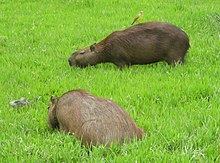

Capybaras foraging
Capybaras are
herbivores, grazing mainly on grasses and
aquatic plants,[SUP]
[9][/SUP][SUP]
[15][/SUP] as well as
fruit and tree bark.[SUP]
[10][/SUP] They are very selective feeders[SUP]
[16][/SUP] and will feed on the leaves of one species and disregard other species surrounding it. They eat a greater variety of plants during the dry season, as fewer plants are available. While they eat grass during the wet season, they have to switch to more abundant reeds during the dry season.[SUP]
[17][/SUP]Plants that capybaras eat during the summer lose their nutritional value in the winter and thus are not consumed at that time.[SUP]
[16][/SUP] The capybara's jaw hinge is not perpendicular and they thus chew food by grinding back-and-forth rather than side-to-side.[SUP]
[18][/SUP] Capybaras are
coprophagous, meaning they eat their own
feces as a source of bacterial
gut flora, to help
digest the
cellulose in the grass that forms their normal diet, and to extract the maximum protein and vitamins from their food. They may also regurgitate food to masticate again, similar to cud-chewing by a cow.[SUP]
[19][/SUP]
Like its cousin the
guinea pig, the capybara does not have the capacity to synthesize
vitamin C, and capybaras not supplemented with vitamin C in captivity have been reported to develop gum disease as a sign of
scurvy.[SUP]
[20][/SUP]
They can have a
life span of 8–10 years in the wild,[SUP]
[21][/SUP] but live less than four years on average, as they are "a favourite
food of
jaguar,
puma,
ocelot,
eagle and
caiman".[SUP]
[12][/SUP] The capybara is also the preferred
prey of the
anaconda.[SUP]
[22][/SUP]
Natural history
Capybaras are very gregarious. While they do sometimes live solitarily, they are more commonly found in groups that average 10–20 individuals, with two to four adult males, four to seven adult females and the rest juveniles.[SUP]
[23][/SUP] Capybara groups can consist of as many as 50 or 100 individuals during the dry season,[SUP]
[19][/SUP][SUP]
[24][/SUP] when the animals gather around available water sources. Males are organized in stable, linear hierarchies. The dominant male in each group is significantly heavier than any of the subordinates, but among subordinates, status is not correlated with weight.[SUP]
[25][/SUP] The dominant male is positioned in the center of the group while subordinates are on the periphery. These hierarchies are established early in life among the young with play fights and mock copulations.[SUP]
[23][/SUP] The most dominant males have access to the best resources.[SUP]
[25][/SUP]Capybaras are very vocal and, when in groups, chatter with each other to establish social bonds, dominance or general group census.[SUP]
[24][/SUP] They can make dog-like barks[SUP]
[19][/SUP] when threatened or when females are herding young.[SUP]
[26][/SUP] Capybaras have two different scent glands; a morillo, located on the snout, and an anal gland.[SUP]
[27][/SUP] Both ***es have those glands, but males have larger morillos and their anal pockets can open more easily. The anal glands of males are also lined with detachable hairs. A crystalline form of scent secretion is coated on these hairs and are released when in contact with objects like plants. These hairs have a longer-lasting scent mark and are tasted by other capybaras. A capybara marks by rubbing its morillo on an object or by walking over a scrub and marking with its anal gland. A capybara can spread its scent further by urinating. However, females usually mark without urinating and mark less frequently than males overall. Females mark more often during the wet season when they are in
estrus. In addition to objects, males will also mark females.[SUP]
[27][/SUP]


Mother with typical litter of four babies
When in estrus, the female's scent changes subtly and nearby males begin pursuit.[SUP]
[25][/SUP] In addition, a female will alert males she is in estrus by whistling though her nose.[SUP]
[19][/SUP] During mating, the female has the advantage and mating choice. Capybaras mate only in water, and if a female does not want to mate with a certain male, she will either submerge or leave the water.[SUP]
[19][/SUP][SUP]
[24][/SUP] Dominant males are highly protective of the females, but they usually cannot prevent all the subordinates from copulating.[SUP]
[25][/SUP] The larger the group, the harder it is for the male to watch all the females. Dominant males secure significantly more matings than each subordinate, but subordinate males, as a class, are responsible for more matings than each dominant male.[SUP]
[25][/SUP] The lifespan of the capybara's sperm is longer than that of other rodents.[SUP]
[28][/SUP]
در اون حد سبیل نداره! گیاهخوار هم هست!
 ) اعتراف میکنم تا یک سال دیگه هم میگشتم به فکرم نمی رسید فوک نباشه !
) اعتراف میکنم تا یک سال دیگه هم میگشتم به فکرم نمی رسید فوک نباشه !

 پستانداران ؟؟؟؟؟؟؟؟
پستانداران ؟؟؟؟؟؟؟؟


